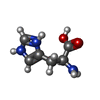[English] 日本語
 Yorodumi
Yorodumi- PDB-1err: HUMAN ESTROGEN RECEPTOR LIGAND-BINDING DOMAIN IN COMPLEX WITH RAL... -
+ Open data
Open data
- Basic information
Basic information
| Entry | Database: PDB / ID: 1err | ||||||
|---|---|---|---|---|---|---|---|
| Title | HUMAN ESTROGEN RECEPTOR LIGAND-BINDING DOMAIN IN COMPLEX WITH RALOXIFENE | ||||||
 Components Components | ESTROGEN RECEPTOR | ||||||
 Keywords Keywords | NUCLEAR RECEPTOR / TRANSCRIPTION FACTOR / STEROID / ANTAGONIST | ||||||
| Function / homology |  Function and homology information Function and homology informationregulation of epithelial cell apoptotic process / antral ovarian follicle growth / regulation of branching involved in prostate gland morphogenesis / RUNX1 regulates transcription of genes involved in WNT signaling / RUNX1 regulates estrogen receptor mediated transcription / regulation of toll-like receptor signaling pathway / nuclear estrogen receptor activity / epithelial cell development / steroid hormone receptor signaling pathway / epithelial cell proliferation involved in mammary gland duct elongation ...regulation of epithelial cell apoptotic process / antral ovarian follicle growth / regulation of branching involved in prostate gland morphogenesis / RUNX1 regulates transcription of genes involved in WNT signaling / RUNX1 regulates estrogen receptor mediated transcription / regulation of toll-like receptor signaling pathway / nuclear estrogen receptor activity / epithelial cell development / steroid hormone receptor signaling pathway / epithelial cell proliferation involved in mammary gland duct elongation / prostate epithelial cord elongation / prostate epithelial cord arborization involved in prostate glandular acinus morphogenesis / mammary gland branching involved in pregnancy / uterus development / negative regulation of smooth muscle cell apoptotic process / vagina development / TFIIB-class transcription factor binding / androgen metabolic process / mammary gland alveolus development / cellular response to estrogen stimulus / estrogen response element binding / Mitochondrial unfolded protein response (UPRmt) / nuclear receptor-mediated steroid hormone signaling pathway / positive regulation of DNA-binding transcription factor activity / negative regulation of DNA-binding transcription factor activity / Nuclear signaling by ERBB4 / RNA polymerase II preinitiation complex assembly / positive regulation of nitric-oxide synthase activity / estrogen receptor signaling pathway / protein localization to chromatin / steroid binding / 14-3-3 protein binding / TFAP2 (AP-2) family regulates transcription of growth factors and their receptors / negative regulation of canonical NF-kappaB signal transduction / ESR-mediated signaling / TBP-class protein binding / negative regulation of miRNA transcription / nitric-oxide synthase regulator activity / nuclear estrogen receptor binding / transcription corepressor binding / transcription coregulator binding / stem cell differentiation / SUMOylation of intracellular receptors / cellular response to estradiol stimulus / euchromatin / beta-catenin binding / Nuclear Receptor transcription pathway / response to estrogen / transcription coactivator binding / male gonad development / nuclear receptor activity / positive regulation of fibroblast proliferation / Constitutive Signaling by Aberrant PI3K in Cancer / Regulation of RUNX2 expression and activity / positive regulation of nitric oxide biosynthetic process / sequence-specific double-stranded DNA binding / Ovarian tumor domain proteases / response to estradiol / PIP3 activates AKT signaling / positive regulation of cytosolic calcium ion concentration / ATPase binding / PI5P, PP2A and IER3 Regulate PI3K/AKT Signaling / regulation of inflammatory response / fibroblast proliferation / DNA-binding transcription activator activity, RNA polymerase II-specific / phospholipase C-activating G protein-coupled receptor signaling pathway / transcription regulator complex / Estrogen-dependent gene expression / DNA-binding transcription factor activity, RNA polymerase II-specific / calmodulin binding / Extra-nuclear estrogen signaling / RNA polymerase II cis-regulatory region sequence-specific DNA binding / chromatin remodeling / DNA-binding transcription factor activity / negative regulation of gene expression / chromatin binding / regulation of DNA-templated transcription / regulation of transcription by RNA polymerase II / protein kinase binding / chromatin / positive regulation of DNA-templated transcription / enzyme binding / negative regulation of transcription by RNA polymerase II / Golgi apparatus / signal transduction / positive regulation of transcription by RNA polymerase II / protein-containing complex / zinc ion binding / nucleoplasm / identical protein binding / nucleus / membrane / plasma membrane / cytoplasm / cytosol Similarity search - Function | ||||||
| Biological species |  Homo sapiens (human) Homo sapiens (human) | ||||||
| Method |  X-RAY DIFFRACTION / X-RAY DIFFRACTION /  SYNCHROTRON / SYNCHROTRON /  MIR / Resolution: 2.6 Å MIR / Resolution: 2.6 Å | ||||||
 Authors Authors | Brzozowski, A.M. / Pike, A.C.W. | ||||||
 Citation Citation |  Journal: Nature / Year: 1997 Journal: Nature / Year: 1997Title: Molecular basis of agonism and antagonism in the oestrogen receptor. Authors: Brzozowski, A.M. / Pike, A.C. / Dauter, Z. / Hubbard, R.E. / Bonn, T. / Engstrom, O. / Ohman, L. / Greene, G.L. / Gustafsson, J.A. / Carlquist, M. | ||||||
| History |
|
- Structure visualization
Structure visualization
| Structure viewer | Molecule:  Molmil Molmil Jmol/JSmol Jmol/JSmol |
|---|
- Downloads & links
Downloads & links
- Download
Download
| PDBx/mmCIF format |  1err.cif.gz 1err.cif.gz | 105.5 KB | Display |  PDBx/mmCIF format PDBx/mmCIF format |
|---|---|---|---|---|
| PDB format |  pdb1err.ent.gz pdb1err.ent.gz | 81.8 KB | Display |  PDB format PDB format |
| PDBx/mmJSON format |  1err.json.gz 1err.json.gz | Tree view |  PDBx/mmJSON format PDBx/mmJSON format | |
| Others |  Other downloads Other downloads |
-Validation report
| Summary document |  1err_validation.pdf.gz 1err_validation.pdf.gz | 932.6 KB | Display |  wwPDB validaton report wwPDB validaton report |
|---|---|---|---|---|
| Full document |  1err_full_validation.pdf.gz 1err_full_validation.pdf.gz | 955.9 KB | Display | |
| Data in XML |  1err_validation.xml.gz 1err_validation.xml.gz | 26.4 KB | Display | |
| Data in CIF |  1err_validation.cif.gz 1err_validation.cif.gz | 33 KB | Display | |
| Arichive directory |  https://data.pdbj.org/pub/pdb/validation_reports/er/1err https://data.pdbj.org/pub/pdb/validation_reports/er/1err ftp://data.pdbj.org/pub/pdb/validation_reports/er/1err ftp://data.pdbj.org/pub/pdb/validation_reports/er/1err | HTTPS FTP |
-Related structure data
- Links
Links
- Assembly
Assembly
| Deposited unit | 
| ||||||||
|---|---|---|---|---|---|---|---|---|---|
| 1 |
| ||||||||
| Unit cell |
| ||||||||
| Components on special symmetry positions |
| ||||||||
| Noncrystallographic symmetry (NCS) | NCS oper: (Code: given Matrix: (-0.740953, -0.502251, 0.445794), Vector: |
- Components
Components
| #1: Protein | Mass: 28947.057 Da / Num. of mol.: 2 / Fragment: LIGAND-BINDING DOMAIN Source method: isolated from a genetically manipulated source Details: LIGAND-BINDING DOMAIN (DOMAIN E - RESIDUES 301-553) IN COMPLEX WITH THE SELECTIVE ANTAGONIST RALOXIFENE Source: (gene. exp.)  Homo sapiens (human) / Strain: JM109 / Gene: ER ALPHA / Variant: C1857 / Plasmid: PEALPHA 35 / Production host: Homo sapiens (human) / Strain: JM109 / Gene: ER ALPHA / Variant: C1857 / Plasmid: PEALPHA 35 / Production host:  #2: Chemical | #3: Water | ChemComp-HOH / | Has protein modification | Y | |
|---|
-Experimental details
-Experiment
| Experiment | Method:  X-RAY DIFFRACTION / Number of used crystals: 1 X-RAY DIFFRACTION / Number of used crystals: 1 |
|---|
- Sample preparation
Sample preparation
| Crystal | Density Matthews: 2.22 Å3/Da / Density % sol: 44 % | ||||||||||||||||||||||||||||||||||||||||||||||||
|---|---|---|---|---|---|---|---|---|---|---|---|---|---|---|---|---|---|---|---|---|---|---|---|---|---|---|---|---|---|---|---|---|---|---|---|---|---|---|---|---|---|---|---|---|---|---|---|---|---|
| Crystal grow | pH: 8.5 Details: 12% (W/V) PEG 4000, 0.2M MAGNESIUM CHLORIDE, 50MM L-LYSINE, 0.1M SUCROSE, 5% 1,4-DIOXANE, 0.1M TRIS-HCL, PH 8.5 | ||||||||||||||||||||||||||||||||||||||||||||||||
| Crystal | *PLUS | ||||||||||||||||||||||||||||||||||||||||||||||||
| Crystal grow | *PLUS Temperature: 18 ℃ / Method: vapor diffusion, hanging drop | ||||||||||||||||||||||||||||||||||||||||||||||||
| Components of the solutions | *PLUS
|
-Data collection
| Diffraction | Mean temperature: 120 K |
|---|---|
| Diffraction source | Source:  SYNCHROTRON / Site: SYNCHROTRON / Site:  EMBL/DESY, HAMBURG EMBL/DESY, HAMBURG  / Beamline: X11 / Wavelength: 0.9054 / Beamline: X11 / Wavelength: 0.9054 |
| Detector | Type: MARRESEARCH / Detector: IMAGE PLATE / Date: Dec 9, 1996 |
| Radiation | Monochromatic (M) / Laue (L): M / Scattering type: x-ray |
| Radiation wavelength | Wavelength: 0.9054 Å / Relative weight: 1 |
| Reflection | Resolution: 2.6→25 Å / Num. obs: 15433 / % possible obs: 95.7 % / Observed criterion σ(I): -3 / Redundancy: 4.5 % / Biso Wilson estimate: 52.5 Å2 / Rsym value: 0.08 / Net I/σ(I): 7 |
| Reflection shell | Resolution: 2.6→2.64 Å / Redundancy: 1.5 % / Mean I/σ(I) obs: 3 / Rsym value: 0.446 / % possible all: 62.6 |
| Reflection | *PLUS Rmerge(I) obs: 0.08 |
- Processing
Processing
| Software |
| ||||||||||||||||||||||||||||||||||||||||||||||||||||||||||||||||||||||||||||||||||||
|---|---|---|---|---|---|---|---|---|---|---|---|---|---|---|---|---|---|---|---|---|---|---|---|---|---|---|---|---|---|---|---|---|---|---|---|---|---|---|---|---|---|---|---|---|---|---|---|---|---|---|---|---|---|---|---|---|---|---|---|---|---|---|---|---|---|---|---|---|---|---|---|---|---|---|---|---|---|---|---|---|---|---|---|---|---|
| Refinement | Method to determine structure:  MIR / Resolution: 2.6→25 Å / Cross valid method: THROUGHOUT / σ(F): 0 MIR / Resolution: 2.6→25 Å / Cross valid method: THROUGHOUT / σ(F): 0
| ||||||||||||||||||||||||||||||||||||||||||||||||||||||||||||||||||||||||||||||||||||
| Displacement parameters | Biso mean: 53.8 Å2 | ||||||||||||||||||||||||||||||||||||||||||||||||||||||||||||||||||||||||||||||||||||
| Refine analyze | Luzzati d res low obs: 5 Å / Luzzati sigma a obs: 0.34 Å | ||||||||||||||||||||||||||||||||||||||||||||||||||||||||||||||||||||||||||||||||||||
| Refinement step | Cycle: LAST / Resolution: 2.6→25 Å
| ||||||||||||||||||||||||||||||||||||||||||||||||||||||||||||||||||||||||||||||||||||
| Refine LS restraints |
| ||||||||||||||||||||||||||||||||||||||||||||||||||||||||||||||||||||||||||||||||||||
| Software | *PLUS Name: REFMAC / Classification: refinement | ||||||||||||||||||||||||||||||||||||||||||||||||||||||||||||||||||||||||||||||||||||
| Refinement | *PLUS Rfactor obs: 0.219 | ||||||||||||||||||||||||||||||||||||||||||||||||||||||||||||||||||||||||||||||||||||
| Solvent computation | *PLUS | ||||||||||||||||||||||||||||||||||||||||||||||||||||||||||||||||||||||||||||||||||||
| Displacement parameters | *PLUS |
 Movie
Movie Controller
Controller


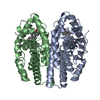
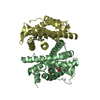
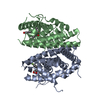





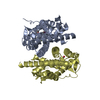

 PDBj
PDBj




